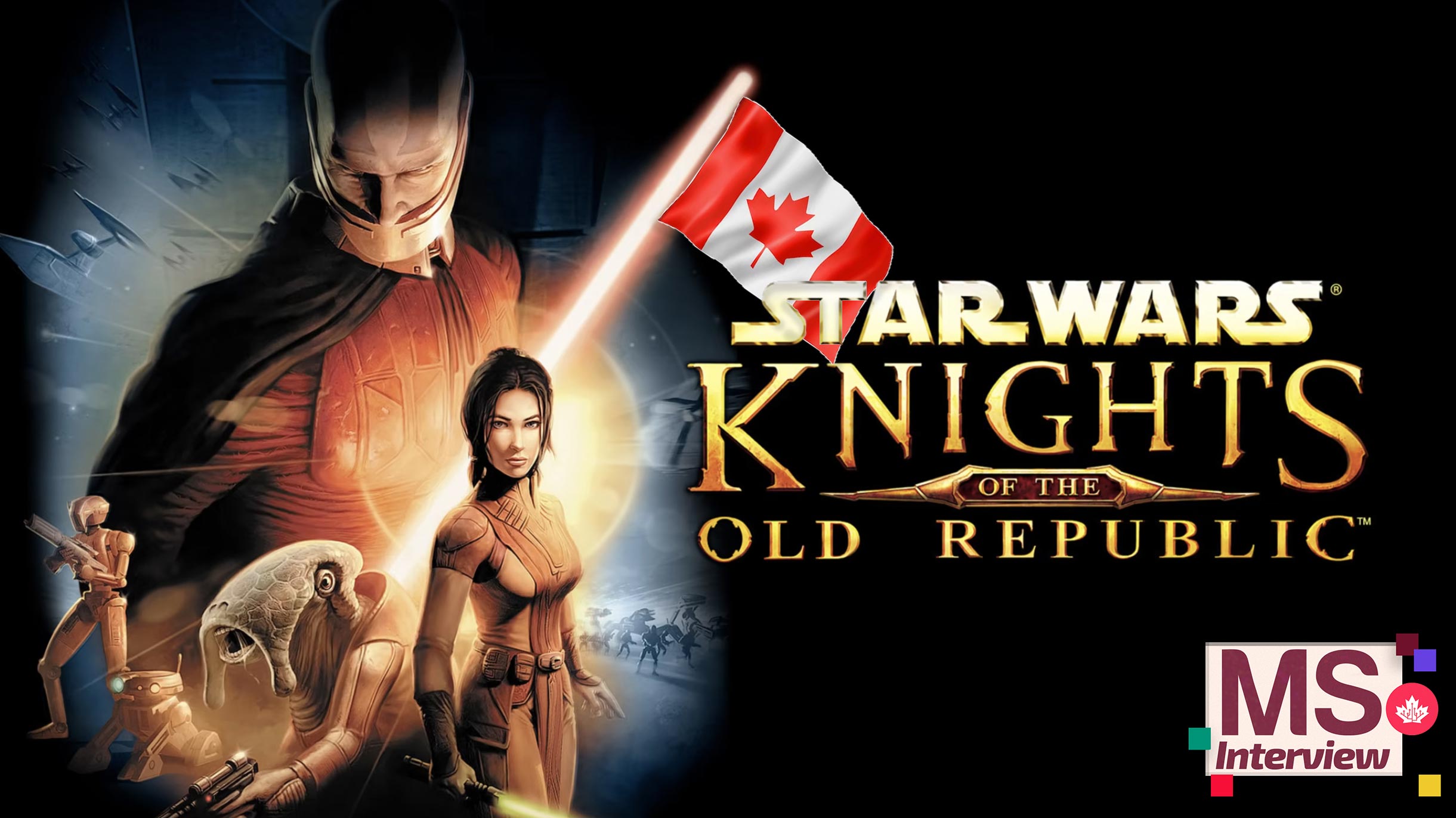
To say Star Wars is a media giant is an understatement.
Over the course of nine mainline films and three spin-offs, four live-action series, and, give or take, a dozen animated TV projects, not to mention well over 100 games and countless books and comics, Star Wars has dominated pop culture for well over 40 years. It’s the quintessential Hollywood success story, with the series creator, George Lucas, starting off with experimental independent films before making some of the biggest and most influential blockbusters to date.
Clearly, Star Wars has an almost mind-blowingly large legacy, but something many people don’t fully appreciate is the role Canadians played in that. In the late ’90s to early 2000s, BioWare, a well-respected but relatively lesser-known studio in Edmonton, released a string of successful games based on the Dungeons & Dragon tabletop franchise. It’s that RPG experience that attracted Star Wars games publisher LucasArts to BioWare, giving the now EA-owned studio — which started as a medical software project from doctors Ray Muzyka, Greg Zeschuk and Augustine Yip — the keys to pretty much the biggest kingdom imaginable.
Enter Star Wars: Knights of the Old Republic, the first-ever — and, to this day, a still-rare — Star Wars RPG video game. In the early 2000s, the prospect of creating your own soldier, training to become a Jedi, and assembling your own ragtag party of Force users, Republic soldiers, droids, and scoundrels to fight the evil Darth Malak — or become your own Sith Lord — was novel. Even now, the fact that it’s set 4,000 years before the Skywalker Saga that continues to dominate so much of Star Wars media feels practically revolutionary. KOTOR was big, bold, and fresh, perfectly capturing that magical feeling of going on a grand adventure with Luke Skywalker and friends in the Millennium Falcon, except this time, you were in the pilot seat.
And upon its release on July 15th, 2003, the game immediately resonated with people. It won Game of the Year at the fourth annual Game Developers Choice Awards and ranks among the highest-rated games for the original Xbox alongside Halo and fellow Canadian-made game Splinter Cell: Chaos Theory. It spawned a popular MMORPG successor, The Old Republic, which is still being supported nearly 15 years after its release, and an acclaimed 2004 sequel. Its long-gestating PS5 remake is one of the current-gen console’s biggest upcoming titles, even if the project has seemed all but dead since its reveal. It cemented BioWare as a developer to be reckoned with and set it up for beloved original IP as Mass Effect and Dragon Age. It even still ranks among people’s favourite Star Wars media, despite the countless Star Wars stories we’ve gotten since its release, let alone in the decades prior.

BioWare Edmonton circa 1997. (Image credit: Trent Oster)
To celebrate 20 years of KOTOR, MobileSyrup tracked down several of the key Canadians behind the game: James Ohlen (lead designer), Drew Karpyshyn (lead writer), Aaryn Flynn (programmer), Steve Gilmour (lead animator), John Gallagher (director of concept art) and Jennifer Hale (the voice of Bastila).
“Together, along with many other talented artists, they made one of the greatest games of all time.”
With classic Canuck humility, several of them are quick to point out some of the game’s shortcomings, like the significant crunch (prolonged overtime) BioWare endured on the project or the decidedly less-than-popular Republic pilot Carth Onasi. But on the whole, they recall the passion and dedication of a team of Canadian D&D fans with big ideas about a galaxy far, far away. Together, along with many other talented artists, they made one of the greatest games of all time.
To celebrate 20 years of KOTOR, we took a deep dive into the making of the game, touching on everything from The Empire Strikes Back, The Phantom Menace and The Mandalorian to Darth Revan, HK-47, and those pesky little gizka. Read on for more from the Canadian creators of Star Wars: Knights of the Old Republic.
The little Canadian developer that could (land the Star Wars licence)
With the abundance of Star Wars media available today, one might take for granted just how special KOTOR actually was. When LucasArts granted BioWare the Star Wars licence in 1999, the scrappy Canadian developer wasn’t the big name it is today, thanks to the likes of Mass Effect and Dragon Age. Naturally, getting to make such a big game in the Star Wars universe — 4,000 years before anything else, no less — brought on a range of emotions in those early days.
James Ohlen: It wasn’t daunting at all because I wanted that sandbox. I’d already learned that [with] IP owners, the closer you are to the important stuff, the harder it gets to do anything that feels epic. And people want to play video games — especially role-playing games — to be an epic hero like the ones in the movies. ‘I want to be like that character in the movies.’ ‘Oh, it’s set in the Star Wars movies? Well, you can not be like that; you can be someone who’s not nearly as important.’ You can still tell good stories, but it’s harder to do. People want to play a Star Wars role-playing game to essentially relive their experiences from the movie as the main character. Now, they want it to be different, but the constant challenge for creatives is to give your audience something that feels familiar but it’s different enough that it doesn’t feel like it’s just derivative. And that was what I tried to do with KOTOR.
Drew Karpyshyn: One of the best things about working on KOTOR was the freedom we were given to tell our story. This was only possible because we were distanced from the movies, books, and other official Star Wars canon. As a team, we were incredibly excited by this incredible opportunity — it was a chance to shape part of Star Wars lore and do it in a way that hadn’t ever been done in video games before.
“Really, Knights of the Old Republic was just this sweet bunch of Canadian nerds getting their hands on the Star Wars IP.” — Steve Gilmour
Aaryn Flynn: It was incredibly daunting. The way my time on the project worked is they kicked it off about six months prior and they’d gotten the publishing agreement from LucasArts, and I was just wrapping up Neverwinter Nights. And so as they were looking to grow the team after everything was approved and greenlit, they needed programmers, so I got the opportunity to change my focus from tools engineering to gameplay engineering because they knew the gameplay expectations were very high trying to get lightsaber combat that worked and looked like lightsabers — these iconic, so important elements of Star Wars they wanted to get in there. And so I was super lucky to get the opportunity to jump over and take about two and a half years of learning at BioWare at that point and then applying it to KOTOR on the Neverwinter engine of all things — which is super weird to think about, this multiplayer PC tools and dungeon master-based game became KOTOR, this single-player, isolated console game.
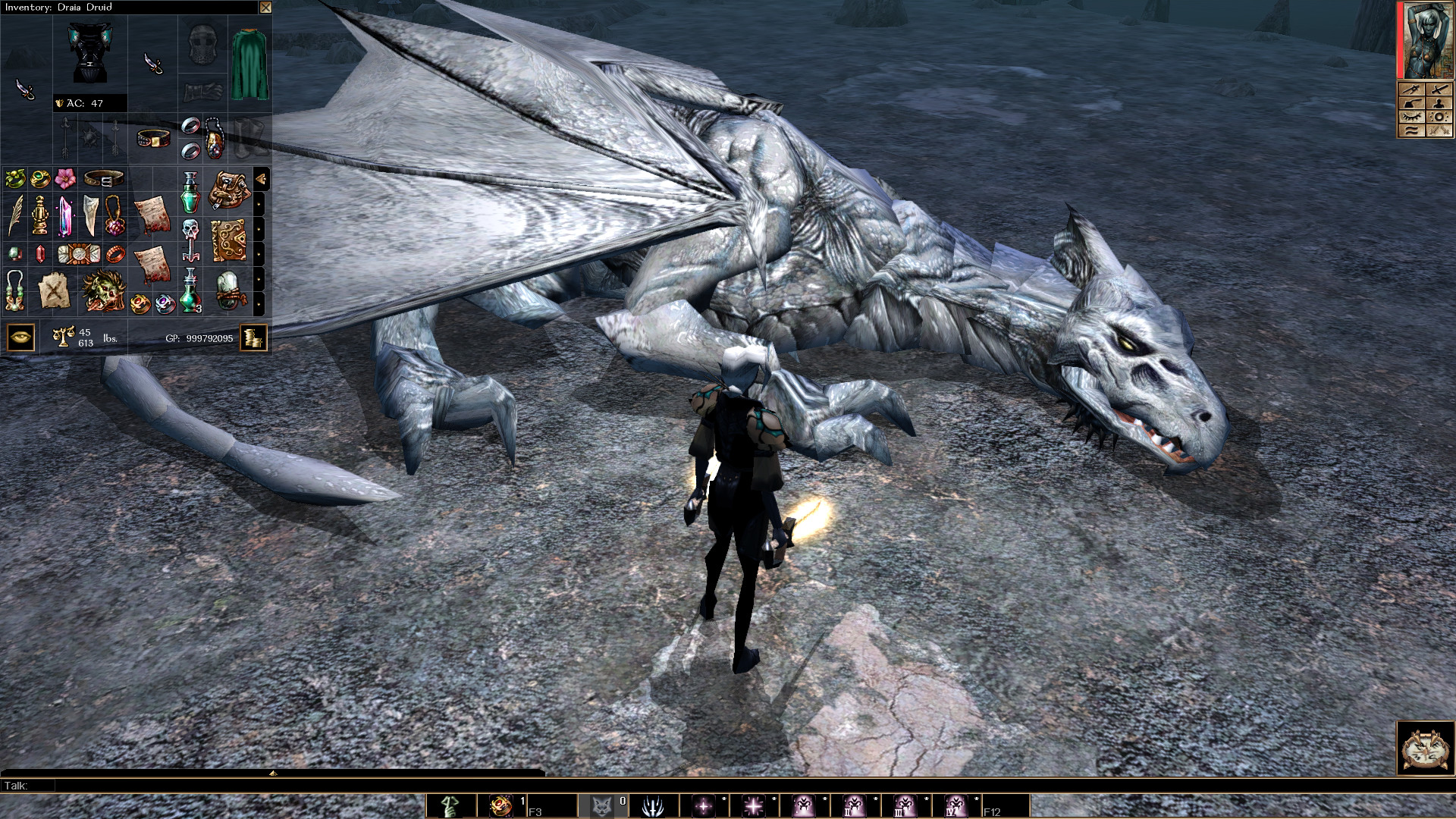
Neverwinter Nights: Enhanced Edition (Image credit: Beamdog)
It was weird because being in Edmonton — or really being anywhere, probably, building computer games — Star Wars just transcends the cultural zeitgeist to where when you say you’re working on something Star Wars-related, everybody gets it. Dungeons & Dragons, it’s like, ‘Oh, yeah, I’ve heard of that,’ but lots of folks hadn’t played it at that point. But as soon as you say Star Wars, everybody gets it […] I think the whole team felt the incredible weight and responsibility of delivering something that would stand with the things we grew up on — these incredible films that we were all raised on and thought, ‘Well, this is some of the greatest storytelling of all time.’ It’s just amazing to see that. And we were just incredibly humbled and, at the same time, very, very committed to ensuring that the game lived and could be talked about in the same breath as Star Wars and The Empire Strikes Back and Return of the Jedi and stuff like that.
Steve Gilmour: For me, it was game number seven, including some expansion pack work. And it came at a time when I was feeling pretty confident about my skills and whether or not I could help and get good stuff done. And we had a very small team; for quite a while, there were just three of us working on that game. So I wouldn’t do cinematics — I’ve always done on the locomotion and the creature combat — that’s the stuff I always focused on. I would help out with cinematics; I love  cinematics, they’re fantastic […] Really, Knights of the Old Republic was just this sweet bunch of Canadian nerds getting their hands on the Star Wars IP [laughs].
cinematics, they’re fantastic […] Really, Knights of the Old Republic was just this sweet bunch of Canadian nerds getting their hands on the Star Wars IP [laughs].
[…] I loved it. I actually liked that freedom. I have to give James [Ohlen] the credit for that decision. He set it 4,000 years in the past, so you can have it be referential without it being a rip-off and also figure out what the tropes are, and ‘let’s tell a compelling new story in this world.’ I believe it did this great balancing act between those two things where there’s enough there that it felt like Star Wars — you really have that experience, especially the first movie, of being on the spaceship and being able to work the blasters and stuff like that. We tried to give you that whole experience of being in a desert town, and there’s a rough little bar, and you can go in and hear the music and see a dance. That’s one of the things I did — the Twi’lek dance for the bars, and I still laugh when I see it. Every time it just makes me howl.
It was fun. It was a great experience. Having that IP offered, we were all over the moon — it was like a dream come true, really. I had seen the original Star Wars in the theatre; it was a levelling experience. I was so excited. And unfortunately, while we were working on KOTOR, The Phantom Menace came out, and we went and saw it. And I remember turning to Derek Watts, the art director, and saying, ‘he’s killed the IP, George [Lucas]. Midichlorians, what? Jar-Jar Binks, what?’ I was just gut-punched. I was terrified that we had just signed ourselves up for something that was going to get destroyed. And it didn’t. [Even though] The Phantom Menace was such a bad movie. [laughs]
John Gallagher: Star Wars was the thing that nuked me from orbit. When I was 10 years old, it changed my life, because it was a young life and I didn’t have a lot in it, so changing it was very easy. Star Wars did that — it just blew my brain matter apart. So I feel like I owe it a tremendous debt of gratitude. And how do you show that love and respect for what inspired you as a kid, except to do your very best? And I knew that I had cut my teeth well enough on the Baldur’s Gate series when KOTOR arrived that I was confident as a creator; I wasn’t concerned that we were somehow going to miss the mark. It was more, ‘How many marks are we going to set for ourselves?’ Because you want to do everything; you want to be the definitive point — the final word — in this, and I think a great deal of that is owed to the [LucasArts] brain trust for keeping us on the rails. Because we very easily could have gotten wildly into over-feature creep to the point where the game would never come out. And we’ve seen that happen with games where they just can’t decide what they are and just suffer an untimely death.
[…] [KOTOR] was really just an insistence on doing the unpredictable thing and doing the more dangerous thing. You’re willing to risk a lot more because we recover a lot more, I think — the elasticity of youth. What we were armed with, I think, is a combination of a couple of things. It was an unwavering belief in our own awesomeness in the sense of we hadn’t failed yet. But I think it’s fair to say, and I won’t speak for anybody else on the team, but I got the sense that there was a collective energy there that was undeniable, given what was in the room […] It was kind of extraordinary just watching it happen in real-time in front of us. It was really quite something.
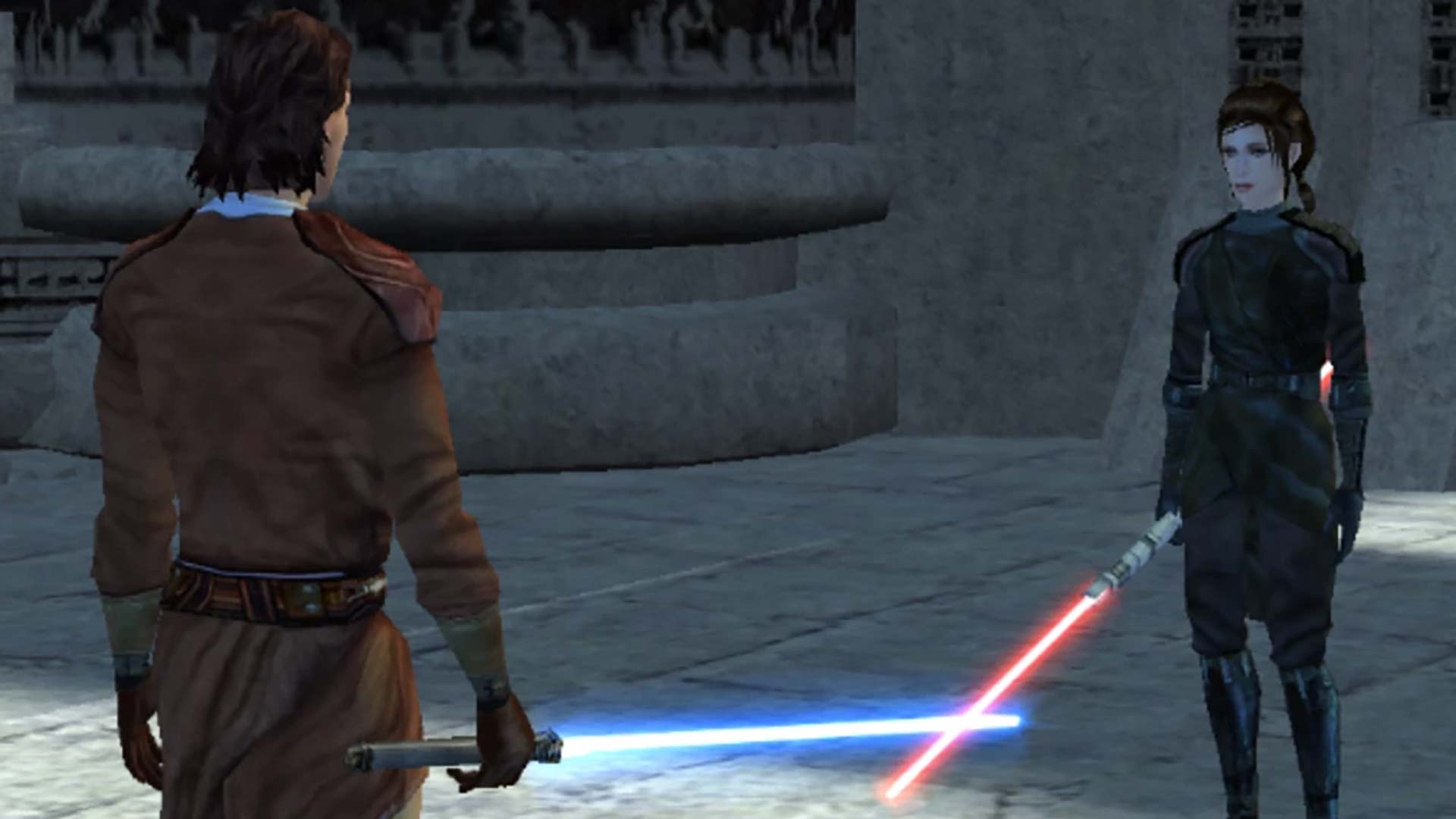
Bastila’s fall to the Dark Side is one of KOTOR’s biggest twists. (Image credit: Disney)
Jennifer Hale: I loved the scope of it — it was massive. And what we did back then — and this is long before the Star Wars Renaissance, if you will — so we had lots of freedom. And it was one of my earlier experiences with such a wide range of possibilities that could happen in a game. I also remember that we recorded all the Light Side choices first in those sessions, and then I came back and they’re like, ‘you’re gonna come back, and we’re gonna do it again with a different thing [the Dark Side path].’ And I was like, ‘What? Okay.’
Because I hadn’t dealt with that before, and I came back, and I’m like, ‘Oh, gosh, oh, wow, now, I have to work a little more to really love this character.’ [laughs] But it was such a great experience. [My director] Ginny McSwain was part of the team. [Voiceover director] Darragh O’Farrell was an incredible guide. It was an absolute blast. And there were no expectations like there would be now because it hadn’t been done yet, and we were just trying stuff. I think BioWare, especially in the early days, created a lot of games they would have just liked to play, and I think that gave birth to some beautiful, beautiful stuff.
Do or do not. There is no try.
Video game development is difficult — much more so, in many ways, than most people probably understand or even appreciate. KOTOR, of course, was no different. Besides the pressure of tackling such a beloved IP, BioWare had to contend with taking the DNA of its past games, including D&D’s dice-rolling D20 system, and translating that into a faster-paced combat experience. Meanwhile, the team challenged itself to make a Star Wars story unlike any before, with practically no warm and fuzzy nostalgic connections to the original trilogy. In their own words, here are some of the biggest obstacles that had to be overcome to achieve all of that.
James Ohlen: We were using the Neverwinter Nights engine, but we wanted to have great lightsaber combat. And luckily, Neverwinter Nights‘ project lead, Trent Oster, really wanted to have great melee combat with swords. But even with a lightsaber, it was tough getting it to work because of the interface. If you think about Neverwinter Nights, it’s a PC game where you just click and you’re okay with not controlling your character.
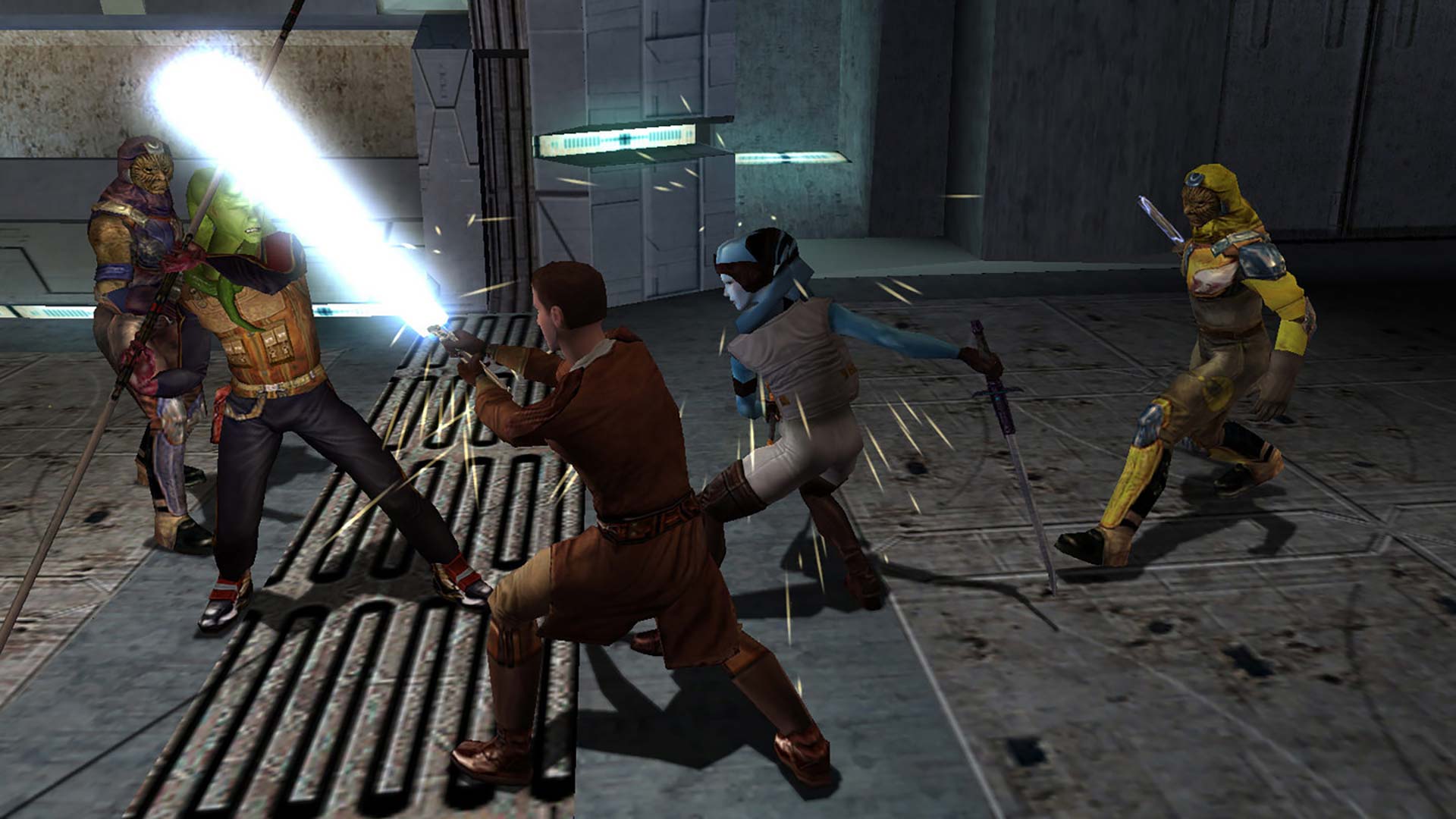
Image credit: Disney
But on a console game where you’re running around in the third-person, it felt weird to lose control in this choreographed fight. So that was one of the big challenges. Now, no one’s gonna say, ‘I loved KOTOR entirely because of the combat.’ I don’t think anybody says that. But we got it to a point where it did its job of selling the fantasy that we wanted you to be living in a Star Wars universe, being the hero in your own story, and feeling like Star Wars. And the minigames are not the greatest minigames in the universe, but their job is just to kind of show you that this is a Star Wars movie where you’re the hero. So I think lightsaber combat was pretty difficult.
Drew Karpyshyn: The hardest thing about writing for games is getting comfortable with the collaborative nature. In addition to working with a team of writers, you also have to be aware of the needs and limitations of every other department, from level design, to art and animation, to programming, to sound and cinematics. Budgets and timelines have to be respected, and you have to understand not just how to tell a story, but how to tell a story that supports the gameplay.
[…] I worked on KOTOR a long time ago, in a game studio far, far away. And we worked hard – crunch time back then often meant 24-plus hours straight at the office. So most of it is a blur. But I do recall the first time I played a level – Manaan – after they had added sound, music, and VO. With the real audio in, everything suddenly clicked, and I knew we had hit it out of the park. It was at that moment I realized all the effort and sacrifice was worth it, and I knew we had really created something special.
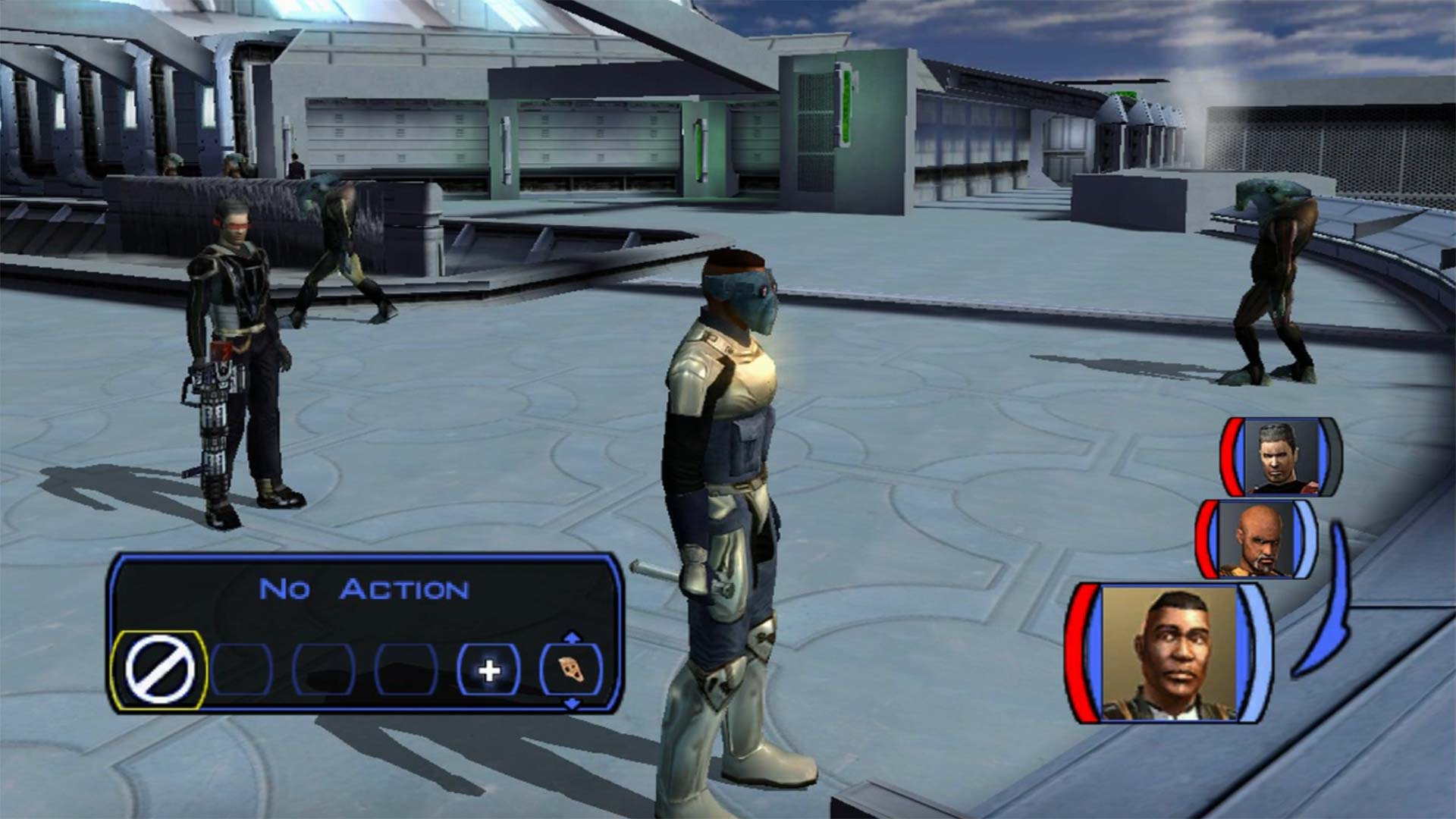
The ocean planet of Manaan. (Image credit: Disney)
Aaryn Flynn: There were definitely technical challenges. We built that game for the Xbox and it only had 64 megabytes of RAM, so there are things like that where you’re like, ‘Wow, we’ve got to fill this in there.’ It was our second or third 3D game at that point, so we were feeling pretty good that we knew how 3D worked. But the biggest pay-off we were looking to do was, for the first time, create a Star Wars game that captured all of the tropes of Star Wars — the lightsaber combat and the cinematic storytelling. And both of those things crossed my desk, and I was just this super energetic, hungry engineer who just said, ‘Yeah, I’m sure we could do it. I don’t know how, but we’ll figure it out.’
And I can remember when Steve [Gilmour], who was our director of animation on the project, walked up to my desk and plunked this book on my desk and it was called The Rules of Cinematography. And looked at it, I said, ‘Okay, Steve, what’s this?’ And he said, ‘We have to get that, into that,’ and he pointed at our TV. And it was all of the rules that as a cinematographer, you place two people to dialogue across from each other, and then the camera must be placed here. And then there are wide, medium, and close-up shots of the person talking. And you can’t ever break the line; you can’t ever have the camera point to one side of a person and then switch to the other side.
You just don’t do that — it’s always on the same side. So you go back and forth. We had to build the software that would do that and respect these rules. And getting it to work, once you figure out the math of it, wasn’t that hard in the grand scheme of things. But then came all of the opportunities to then create new kinds of cameras — tracking cameras and gimbal cameras, and all these things that the cinematic designers and cinematic animators at BioWare really started to invest in over the course of Mass Effect and future titles. But just capturing that feeling of Star Wars and making sure that that it was unequivocally a Star Wars game –not just because it had Star Wars on it, it looked and felt like a Star Wars game — was constantly in our minds. ‘Can we do more here?’ Can we do more to do it that way?’

Image credit: Disney
Steve Gilmour: Combat took forever — it felt terrible for a very long time. Because it is the awkward balance between the turn-based and [real-time]. Like, you want it to feel action-y but you’ve applied a turn-based system. I’d never make that call now! It’s relying on your audience to be very patient; it’s too big of an ask nowadays, I would never, ever do this. But at the time, it felt like a good hybrid solution to get us sort of out of D&D and closer to something that felt more action-y. And that felt pretty good, cresting that hill. And we tried a lot of stuff; I would build animation assets and give them to the design team.
[…] They wanted three different lightsaber styles — a single sword, like a samurai, two hands, so two swords, and then staff, like Bastila’s or Darth Maul’s. And the problem was, in the base combat, each one of those times that I attack, it’s a turn, and in that turn, I have the chance to either succeed or fail. So I either swing and hit you, like swing through, and maybe there’s a VFX explosion, and you take some damage, or you actually parry and catch it. And I had to figure out how to have all three different weapon types interact with that succeed-or-fail outcome together, and to make it look like a duel, but also fit that very functional structure. And that’s what I actually built. If you were to watch the base combat, basically, it doesn’t matter which weapon you have, you strike in the same spot — it’ll be a different animation — but it will strike in the same spot and the person will either catch it or get hit by it and show damage. And we had to build those scenarios for everything.
And then you could switch on the fly even and it would all fit correctly — all the animations would actually work. And it didn’t matter which weapon type you had, or which weapon the person you were fighting had for the melee combat. So it actually wound up being a very robust, really good system. But hilariously, that took a huge amount of animation work to build. And what most people wind up doing is they start using their Force powers over and over and over again, and things like the flip attack with a single saber. People will just line it up in the little queue and it’ll just play over and over and over again and it’s like, ‘oh, all that animation work, nobody sees it — it took so long and just nobody sees it!’ But that’s the life of a professional art creator — you don’t have control over those things. But getting that to work was very tricky, and once it was working, it was great.

KOTOR lets you use both Light and Dark Side powers, including Force Lightning. (Image credit: Disney)
John Gallagher: I think the biggest challenge was, ‘How do we honour it?’ And then you get down into the tangibles and the intangibles — it’s almost like muscle memory. They’re like, ‘Let’s start building ships and buildings and droids and everything else. How do we create memorable characters without defying all Star Wars canon?’ So there are a lot of questions you’re asking. But once you get into the meat and potatoes of building a game, then it’s just largely muscle memory by then. You’re just like, ‘Let’s get the lists, let’s start world-building, let’s get the design docs, let’s know what this thing is and what it isn’t. And then [there’s] just the general existential horror of how Star Wars fans can be [laughs]. Even to this day, I consider myself very fortunate in that regard that what I had to do with Star Wars is cherished, so I don’t get any of the flack that some people who’ve worked on things that maybe weren’t greeted with the most love. And it’s totally unnecessary to do somebody anyway — I think it’s really shitty behaviour in general. […] But it’s nice to be associated, of course, with something that is so honoured by Star Wars fans, because we’re all Star Wars fans, universally, on the team — certainly the [heads of departments] all were. None of us were cynical — we were just like, ‘How do we make an awesome Star Wars [game]?”
A twist worthy of Lord Vader himself
Arguably, the most iconic moment in the entire Star Wars pantheon is Darth Vader revealing himself to be Luke Skywalker’s father. And yet, it’s a twist that wasn’t exactly well set up, with much of its shock value stemming from the fact that it pretty much came out of nowhere. BioWare, however, was so bold as to take inspiration from the pivotal Empire Strikes Back scene while dramatically expanding upon that concept. Using the uniquely immersive qualities of a video game, the developer dared to ask: what if you, the player, were actually Darth Revan, the Big Bad Villain who’s been constantly built up over the course of dozens of hours of playtime?
Seeds were also carefully planted throughout the story so that when Darth Malak delivers this earth-shattering revelation in the latter half of the game, you actually understand how it all lines up. The icing on the cake is how the game concludes the reveal: a flashback of Revan removing his helmet while the camera pans around him dramatically to reveal the player character’s custom face under the hood. Going back to Ohlen’s earlier example about players wanting to be a big, important character in Star Wars, the brilliance of the Revan twist is that the main protagonist of KOTOR is simultaneously whoever the player shapes them to be, and a Sith Lord as infamous and feared as Darth Vader.
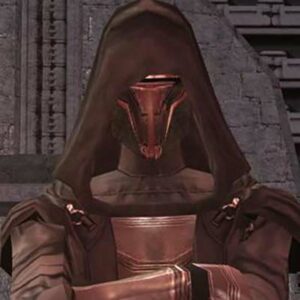
Players had their minds blown discovering who was behind Revan’s striking mask. (Image credit: Disney)
James Ohlen: The twist was the core of the story from the beginning — ‘What is a twist that hasn’t been done before?’ It was actually [my friend] Cameron Tofer originally who was like, ‘What about this?’ ‘No, that’s been done…’ Just going back and forth, ‘What is the twist?’ And then I was like, ‘You are the main villain. Now that could be totally stupid and ridiculous.’ [laughs] ‘But [what] if you can pull it off?’
It’s surprising that when I ask people if they’re able to see where I got inspired by certain scenes, they’re often unable to, and I’m like, ‘But I literally ripped it from…’ and then I’ll describe it to them and they’ll go, ‘Oh yeah, it was that scene!’ [laughs] You’ll know what my favourite scene in all of the Star Wars original trilogy is if you know the most important scene from KOTOR… The twist! But no one gets it! Because it’s like The Empire Strikes Back — the hero has to go and face off alone against Darth Vader, the Dark Lord, and then they have an epic lightsaber fight where he gets his ass kicked, and then the Dark Lord reveals a big secret that changes everything for everybody, and then the hero has to get rescued barely by his friends in the Millennium Falcon — I mean the Ebon Hawk. [laughs] So many people don’t know. It was hidden enough that when you’re playing, you’re just like, ‘Wow, this feels so awesome. It’s like my favourite movie!’ [laughs]
Drew Karpyshyn: I think the player’s connection with Revan made the twist feel even more powerful, so we saw this as an opportunity rather than an obstacle. We were careful not to force anything on the player, or to make them feel like we were steering them or not ‘playing fair’ with the twist – we didn’t want to invalidate their own experiences in the game. We knew if we were careful to craft the game to allow for freedom and choice, yet still have the reveal make sense and fit with what happened during the story of the game, that it would resonate even more strongly.
Aaryn Flynn: The way that the Darth Revan twist became so, so shocking to people, I think that was what really paid off. I’m sure nowadays that would be leaked with the internet the way it is and everything — I don’t know that you could have done that nowadays. Even if you did that game five years later, it might have leaked. But back then, it really did floor people, and you could even play it a few months after it came out and you still didn’t know because you weren’t on Twitter and Facebook and social media and other things, so you’re just constantly inundated with these kinds of leaks. So that was really cool, that it worked for so many people. It’s probably never going to happen again absent some event where literally everybody’s watching a show at the exact same time and then you get it. But that was really cool that that worked for players. It’s maybe fair to say that it was a moment in time that worked and might not be doable anymore.
Steve Gilmour: It’s funny. The game had shipped, I went to Vancouver for vacation, and I was just walking in the West End past Safeway. There were some guys out back on a picnic table, and they were talking about KOTOR. And this guy’s describing the Revan twist to his buddy, and I just started laughing. It’s awesome. I just smiled, man. I didn’t want to take credit. They were so jazzed and this guy was so excited talking about — that’s all I needed to hear, the excitement in his voice. It’s just like, ‘We did something cool, we really did!’
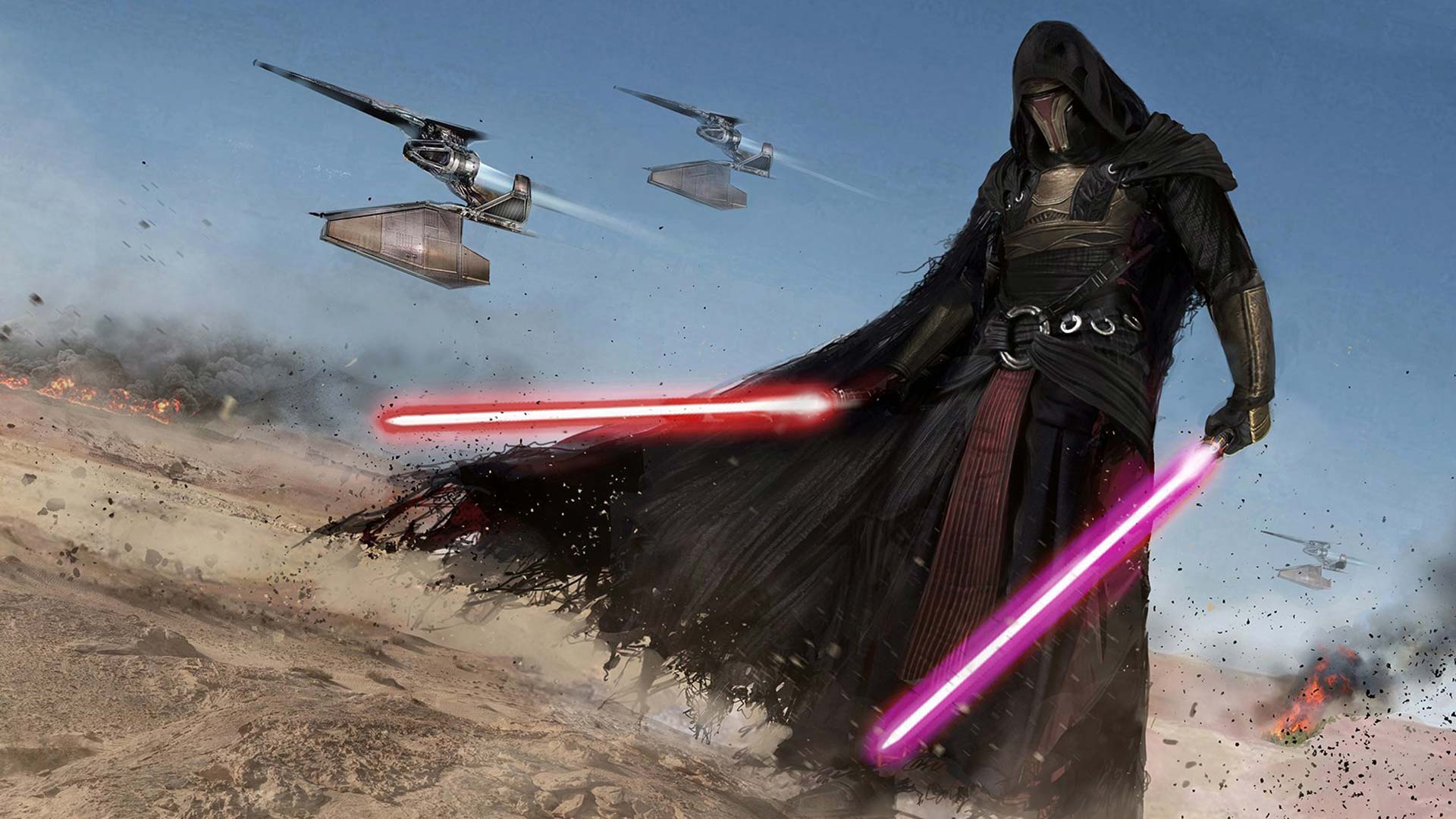
Darth Revan. (Art by: John Gallagher)
[…] That’s the advantage [with the Revan twist]. If you make your own character, then put that character in the cutscene — back then, nobody was doing that. And so it was that much more powerful that I created or chose this face. I think it was a grid of nine choices, but those details of connecting the art to the experience and making sure it all works together in a really comprehensive way — that’s how you get those narrative moments to pop. Nothing comes between you and that experience. Literally, the person you’ve been staring at for the last 20 hours is that storied person. They handled it so well.
John Gallagher: At the time that we were given the assignment [of making KOTOR], we had different lore. It wasn’t as deeply, richly inhabited; all the Star Wars fans who started creating content at the highest level had already had two decades to do that like we’re seeing now. So if I was designing Revan now, I’d probably approach it quite similarly in the sense that mystery is everything. There had to be some tribal aesthetic in there somewhere. We weren’t sure where it was coming from — you could read it as maybe a little bit Tusken Raider, a little bit more Bedouin. The mask could be an extrapolation from a Mandalorian helmet. You’re never quite sure. And that’s the whole point — it’s like a postmodern ‘mixmaster’ in the sense that you have to throw cues into the design that may take people off in a different direction to speculate.
“The execution of the big twist was a watershed moment in video game narrative.” — Drew Karpyshyn
And that’s why the internet’s wonderful because it will say, ‘Yeah, I think they were thinking this and this and this,’ and I’ll go onto a message board and say, ‘Well, I designed it, I can tell you no, but that’s a really cool idea. Holy crap, that’s amazing!’ But I can’t take credit for anything other than having a really good support team, and everybody along the line after that helped create that character […] Everybody else along the way really brought the character to life, from dialogue to animation to modelling to texture. So that’s very exciting to watch as a concept artist, because when I’m doing illustrations, I can picture in my head what it’s going to look like, or how it’s going to move, and I have notes and I’ll say this what my thoughts are, and I’ll talk with the animators to talk with the modellers and stuff. But generally speaking, the fascinating process is being a part of it and watching it continually evolve and improve and get more exciting as it goes along the line.
I don’t really have a definitive answer [to how I designed Revan] other than I use the same sort of neural mapping I always do when I’m trying to create something interesting. Because I just go ‘pick, choose, pick, choose, pick, choose,’ and just do this diametric and hope some of it works out. But it was pretty clear from the start where he was going to end up. He had to have the hood, he had to have the long robe, he had to have all of that. There’s no way he can’t. We were wanting to create this iconic silhouette, and you absolutely have to have the gear. And we weren’t heading in a direction, for example, like Darth Maul, that was clearly staked out territory in a different way. We didn’t want to go down that road […] I had a very clear idea, a pretty narrow lane that I wanted to go down to see what we could come up with. And I didn’t draw any real cues other than some African tribal masks. I love that sense of elongation – like it’s longer than a face should be. And you’re like, ‘Is there any alien head under there? What’s the deal?’ Because you start to speculate a little bit that it looks like it’s a little bigger than it should be. Is there a human under there?’ What’s going on? So I think just having a little bit of mystery around the edges of character is everything, and we did a pretty good job with Revan.
Bastila, a Force for change
While Revan is the actual lead character, equally as important to the story is Bastila Shan. Thanks to the unique Force ability known as Battle Meditation, the young, headstrong Jedi could boost the overall morale and battle prowess of entire fleets, making her an invaluable addition to the Galactic Republic and a formidable threat to the Sith. Beyond that, though, her character was something of a trailblazer, one of the first female Jedi at a time when they were largely relegated to minor background roles in George Lucas’ prequel trilogy, and years before we’d see high-profile leads like Rey and Ahsoka. For Jennifer Hale, Bastila remains a standout character in a career full of many iconic women.
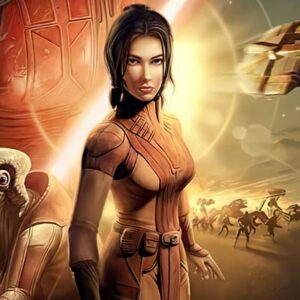
Bastila. (Image credit: Disney)
Jennifer Hale: It was awesome. I’ve had the great privilege of playing female fighters going way back. It’s just part of who I am — I was influenced by the women who came before me, who led the field in the women’s rights movements, and it just seemed so obvious to me that the power needed to be redistributed more equally. And that fire definitely burns in my soul on all counts. There are marginalized groups of people today who I cannot wait to see empowered — Indigenous people top that list. But one of the things I did when I very first moved to LA was to work in film and television, and I did, but not often enough to support myself full-time. [laughs] Which was a shock, because I had spent the previous eight years working full-time as an actor in Birmingham and Atlanta. And so I made a voiceover tape, honestly, just to get commercial work. And I used to bug my agents because I would read the copy. And I would see, ‘Oh, I’m reading for woman number four.’ But I knew enough to know that announcer often means repeat business. And I was like, ‘Um, can I read for the announcer?’ And they would say, ‘Well, they want a man.’ And ‘I know, can I read anyway?’ I did that so many times. I’m surprised they didn’t just squash me like a bug because I was probably so incredibly annoying.
But eventually, within a few years, I could not turn on the TV or radio without hearing myself — I kicked that door down. And then I moved on. And I still continue to do that kind of work from time to time, but I’m beginning to realize my real passion is breathing life into stories of the human soul, uplifting and empowering that piece of our experience and everybody around me that I possibly can, and putting on some really gnarly boots and kicking down every door, that in my perception, should never have been closed.
[…] She’s such a shining example of so many things — her own humanity and the light and the dark, and the fact that that [fall] can happen. But she’s, for lack of a better word, a badass. Who doesn’t want to play that? She’s a Jedi! Like, what? Are you kidding? Yes, please! The Jedi are something — whatever you want to call it — that I’ve aspired to be, that level of being, for my whole life. Like, why wouldn’t I? […] It’s the title of Jedi — it’s all the things that being a Jedi represents and embodies. And what you quickly overlook is what’s required to become a Jedi — all the work. So to be able to take that shortcut and just step in and be one? Yes, please! [laughs]
[…] It’s [also] interesting to look back on it 20 years later because nowadays, I enjoy playing a good villain. I enjoy playing a good Dark Side [character]. It’s just fun. I let myself have fun. I think I was probably a little more tight with myself back then because I just felt bad. I felt so guilt-ridden. [laughs] What am I putting out into the world? And then I remind myself, ‘Hey, it’s a game, let’s go!’ Then you drop into the fun of it.
A truly cinematic experience
A major contributing factor to KOTOR‘s strong narrative is its high-quality presentation for a 2003 game. It really did look and feel like Star Wars, and a big reason for those filmic qualities comes from the involvement of Hale and countless other actors. At the suggestion of voiceover director Darragh O’Farrell, LucasArts gave KOTOR a big enough budget to have recorded lines for the entire experience, which was practically unheard of in the early aughts. This allowed for the massive script, which included roughly 15,000 lines of dialogue for about 300 speaking characters, to be sent out to Hollywood agencies, bringing on veterans like Hale, Phil LaMarr and Ed Asner. At the same time, this meant that BioWare had to create a facial animation system to account for all of the characters. A huge undertaking, to be sure, but one that helped make the Canadian developer’s take on Star Wars feel lived-in and authentic.
Jennifer Hale: It was so intimidating to see [the script] when I walked in. I was like, ‘Oh, my God!’ [laughs] And this is what many people don’t realize: that was cold reading. We don’t get these scripts ahead of time in most cases. We’re beginning to [in] about 15 percent of the cases, maybe 20 percent, but that’s a very, very recent development. Every game actor you respect and admire — take a step back and notice they did that cold. They walked in, they saw the mic stand empty, maybe some paper was put there, maybe a touchscreen, and somebody said, ‘let’s go,’ and they just went for it. And within a couple of takes or a few takes, it goes to market, and you’re hopping around on the timeline. I might record something from the middle of the game, followed by something from the beginning, now let’s hop to the end, now back to a third of the way through, and that’s your day. And you just have to just jump. My peers in this industry are some of the most gifted, extraordinary performers I’ve ever known.
[To do that], you rely heavily on one of the most under-celebrated positions in game creation, which is the voice director. They are instrumental in crafting how this sounds. I often say these people are responsible for much of the tone of modern pop culture. They pull these performances out of us on the spot, while receiving a ton of data from behind them — producers and writers and directors, everybody’s sitting and giving them input. Nowadays, a lot of it is on Zoom, but you get the picture. They take all that information and funnel it through this one talkback mic into our ears, and we pull on the full capacity of our experience and expertise and skill and intuition and everything else, and we make something happen at that moment that is as magical as we can possibly make it.
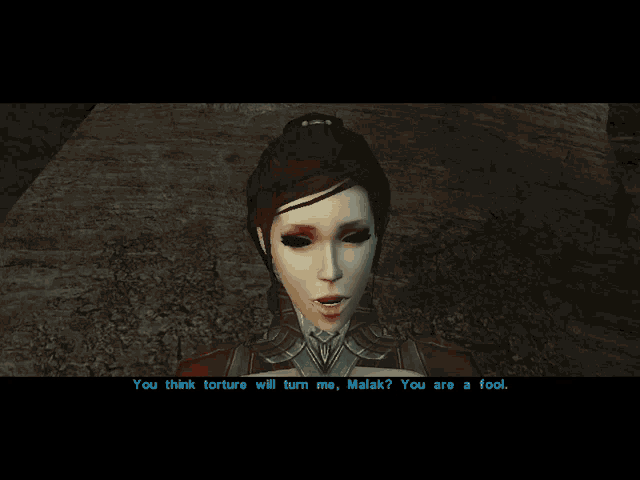
KOTOR‘s facial animations are quite expressive for a 20-year-old game. (GIF credit: Disney)
Steve Gilmour: Another thing we did was phoneme recognition, so all the facial automation for dialogue was being driven procedurally. So we set up a system, and this was Casey Hudson’s idea — he came to me with this software technology called Animeter. And basically, it’s a system for quantifying and being able to replay facial expressions, or phonemes. So each facial expression shape that you make to make a sound like, ‘ooh,’ that’s called a phoneme — the mouth shape I make, the muscles that have to fire to make it happen. So you can quantify all the facial shapes and actually build a system that will play this stuff on the fly based on a WAV file, so we’ll do it from voice. And it does its best to kind of figure out what face shape should play and then I’ll pick, and then you had ways to edit and give it feedback. And honestly, it’s a lot like AI right now; the process for sharpening up an AI is very similar. You get the base system working and then you actually maybe go in and tinker and say when this kind of ‘L’ sound needs to directly take this kind of face shape, stuff like that.
So we set that up in KOTOR in 2003 and I don’t know if anybody else had ever done that before. I know that technology existed, but it was being used for things like casino characters on slot machines. I don’t know if anybody had ever used it for a game before. But the upside was these characters, if you put a line of Japanese dialogue in, would do their best to kind of look like they’re speaking Japanese. So we built a system that was procedural that wasn’t as good as perfectly captured faces in real-time with a super close-up camera, but it was 2003. Half this stuff, of all the knowledge that exists right now, didn’t exist back then. How far they could push faces and how good of a relationship you could make with the technology in the audience, that kind of thing… None of that was known. So people were taking their best shots at it. But there’s also kind of a sweet spot of looseness that things didn’t work quite perfectly; the faces didn’t quite shape the way they were supposed to, or some shapes look a little flat or not quite right.
“…I think that the success of KOTOR was really that it validated, for a lot of the industry, that kind of opportunity for storytelling.” — Aaryn Flynn
But when we had so much dialogue to get through, that was the big challenge, especially with BioWare games. The amount of dialogue — you’re talking several novels’ worth of dialogue, hundreds, possibly. My wife worked on a lot of this stuff at BioWare, Shauna Perry, she was the audio lead for quite a while. Having to worry about dialogue, all the different SKUs, language SKUs, all this stuff. So we were always really paranoid and freaked out about how much work [goes into] getting our characters to say all this dialogue that we write for BioWare games, all that mountain of work — what’s the smart way to get your characters to do it? And I actually still think this is the best way, which is you build some kind of procedural system that is so robust, you don’t need to care. I can send the game to Japan, I can get it localized, I can take all that dialogue, plug it in, and it’ll actually work, and these characters will mostly look like they’re speaking Japanese.
I sense something; a presence I’ve not felt since…
When Disney bought Star Wars in 2012, Lucasfilm relegated most of the series’ media outside of the films to non-canon ‘Legends’ status, KOTOR included. And yet, the enduring popularity of BioWare’s masterpiece meant that many Star Wars creators have kept returning to that well to bring elements of the game back into canon. In Rogue One, the Republic Hammerhead cruiser pops up. George Lucas commissioned a since-deleted scene with Revan for The Clone Wars‘ popular ‘Mortis’ arc, in which Obi-Wan, Anakin and Ahsoka travel to a mythical planet with ties to the origins of the Force. Even James Gunn, the celebrated writer-director of Guardians of the Galaxy and current DC Studios co-CEO, has said KOTOR is his favourite game and was even an influence on his films. That begs the question: what’s it like to see your work referenced and even adapted into other big properties?
James Ohlen: So I’m watching the first episode of The Mandalorian Season 2, and I’m like ‘Wow, Episode One’s just not very good.’ And I love The Mandalorian by the way. I was like, ‘What the hell is this plot? He’s going to team up with the sand people, that seems kind of just arbitrary, and they’re gonna kill a Krayt Dragon. What, the Krayt Dragon lives in a cave? That’s dumb. And they’re gonna put a — Wait, what? that’s literally KOTOR!’ It dawned on me; I went from ‘I don’t like this’ to ‘now I know why it’s so dumb — because they based it off KOTOR!’ [laughs] I was so happy about the dumbness then! I was like, ‘Ah, keep doing that!’
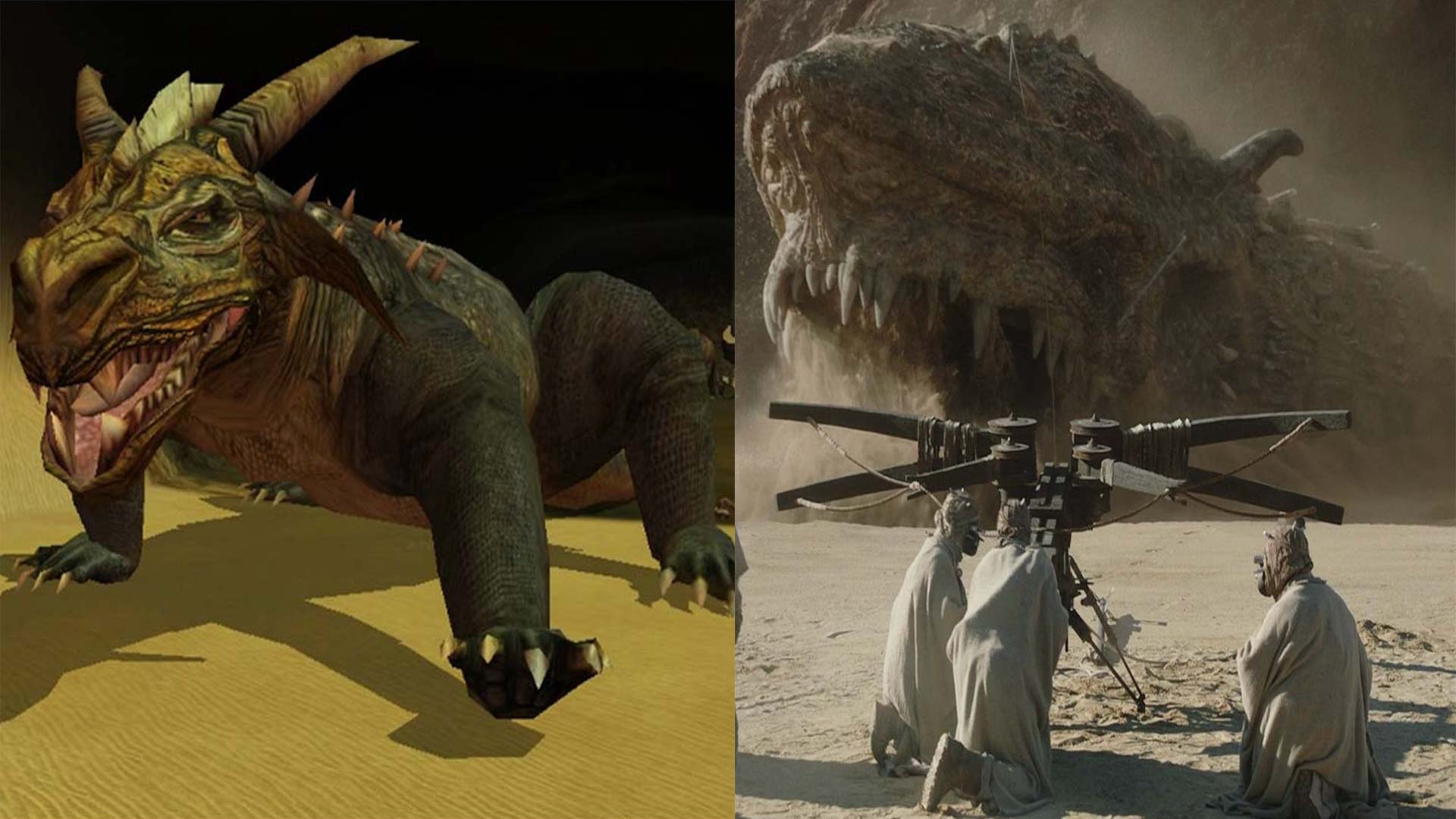
The Krayt Dragon in Knights of the Old Republic vs. the one in The Mandalorian. (Images credit: Disney)
Those things are all kind of dumb, and the reason they’re all kind of dumb is that the Krayt Dragon was never going to get into the game. The Krayt Dragon had a great model, it looked awesome, and it could walk forward, but as soon as it turned or did anything, it looked like complete shit because we didn’t have animation blending or anything like that. And it’s a big long creature — I was always like, ‘We can’t make big long creatures because they always look terrible when they turn.’ Modern video games have managed to solve that, but back then, it was just awful. And so everyone was like, ‘Oh, I guess we’re not gonna have the Krayt Dragon.’ And I was like, ‘No!’ One of my qualities as a designer is ‘we can’t waste anything! We got to have to create training.’ And I go, ‘Okay, he can only walk forward, I’ll put him in a cave, he can’t turn there. He’ll just walk forward in the cave. But if he gets into combat, it will just explode, so how does the player kill him? Well, kill him by blowing him up with mines! But then how do they get them to come out of the cave? A Bantha!’ It was literally just me trying to figure out how to use the model with the animation. So all of those plot elements feel dumb in a TV show because they’re there to compensate for the fact that if the Krayt Dragon [in KOTOR] turns or does any combat moves, it’s all over. [laughs] It’s gonna look like crap.
“And I still feel like we should have done the sequel. Me and the art director were arguing to do it, that we really wanted to do it, but LucasArts came up with a 12-month schedule…” — Steve Gilmour.
So I use that story with designers saying, ‘This is why you should always use content. You can’t waste content — you never know if it’s going to be something. If it’s great, even if the content doesn’t fit perfectly, you’ve gotta use a great piece of content, you can’t waste it. You never know when that [could be used]. And by the way, Drew Karpyshyn went ‘that’s what he loved about KOTOR?” [laughs] I love all of Jon Favreau’s Star Wars stuff, but that definitely was one of my favourite parts, just because of the greater homage to KOTOR.
Drew Karpyshyn: There have been so many moments it’s hard to pick just one. That’s the great thing about working in a universe as wide-ranging as Star Wars – you get to see bits and pieces of things you helped create popping up over and over again.
Aaryn Flynn: The Krayt Dragon was really cool — I worked on the Krayt Dragon. I remember going like, ‘Oh my god, we’ve got to do what?’ [laughs] So that was really fun. Credit to the writers who helped build out this mythos from 4,000 years earlier that is now a respected part of the Star Wars mythology. And now you see it coming out and you them doing stuff like that. I just programmed and I didn’t make that stuff up — that’s a credit to the writing team and everything. But it was amazing to hear them talk about things and you’d say, ‘So we can really do this?’ And they would say, ‘Oh yeah, they’ve been great, LucasArts has been really good to us about this, that’s great.’ So it is neat to see 20, almost 25 years later, some of those elements of their lore, of that game’s lore, who were the first to do it now being elevated in the Star Wars pantheon.
-

- The Hammerhead in KOTOR.
-
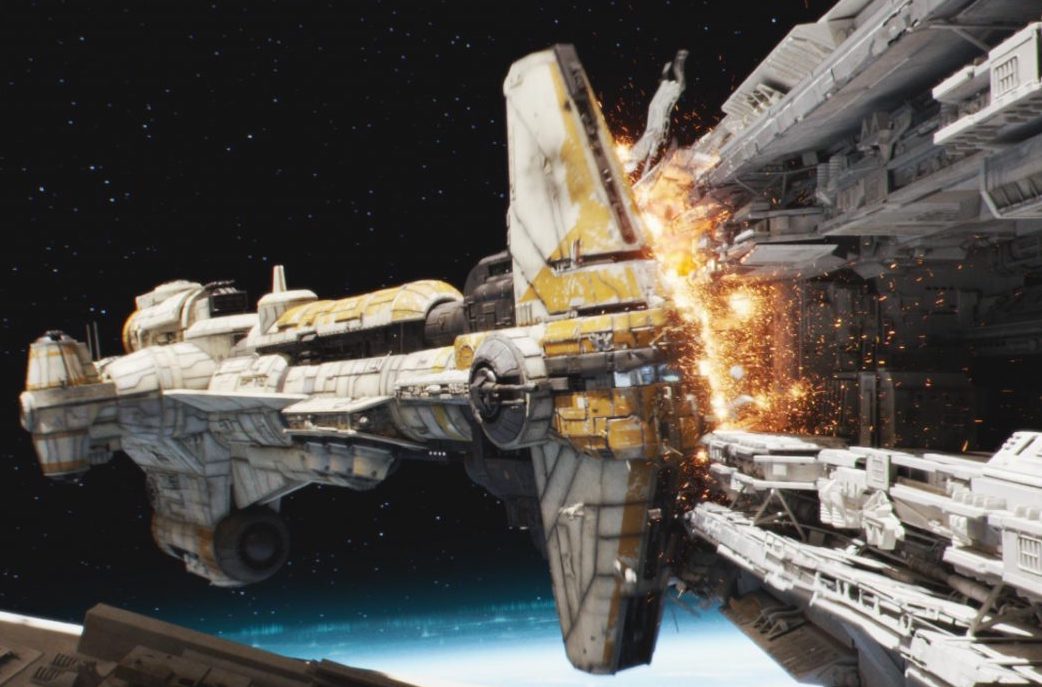
- The Hammerhead in Rogue One. (Image credit: Disney)
Steve Gilmour: Some of the ship designs [like the Hammerhead in Rogue One]… Also, just the ideas of what the combat could look like — that it could be more frenetic, that there could be a lot more Force powers up. Because it’s an RPG, you keep leveling up, you keep getting new Force powers, and by the end, you can do a lot — you’re pretty powerful. And we hadn’t really seen that in the movies a lot up until that point […] And I think the new games are definitely taking from that as well. It kind of showed, I would hope, that KOTOR was showing a path for more game development.
And I still feel like we should have done the sequel. Me and the art director were arguing to do it, that we really wanted to do it, but LucasArts came up with a 12-month schedule to do a sequel [which BioWare turned down]. And honestly, I would have [done it] — I would have tried my best. I was totally down to do more of those. Obsidian did the sequel […] I’ve never played the second one. I should, but it just felt so wrong that they did it and we didn’t. But I kind of had a hard time with that. I think maybe now I could play it, but for a long time, I was like, ‘No, I want to stay in my lane, I don’t want to see other people’s stuff there.’ And also, you’ve given them so many ideas to work off of that it feels sort of like cheating. Because it was your stuff, right? Like, everything that’s in there is pretty much us –what we could glean from the movies. So much of the creativity is kind of a frontier, expedition-type creativity into the Star Wars universe. And you see a bit of that like Andor, The Mandalorian is a bit more like that. I liked Rogue One. But they’ve done so much, they put a lot of burden on the IP, and I think it’s time to just let Star Wars alone for a while. [laughs]
John Gallagher: Actually, the Krayt Dragon was the first one [I saw from KOTOR elsewhere]. And they did such a beautiful job with it — that looks way better than anything I did. [laughs] I don’t get too wound up about that stuff. But I did get asked an awful lot after [The Force Awakens] came out, ‘How does it feel to have Darth Revan bastardized like that?’ And I said, ‘That’s not Revan! Adam Driver’s out there giving his all because he’s got nothing to work with, but that’s not Revan. You need Keanu Reeves to be Darth Revan — that feels much more his demeanour.’ But yeah, seeing the Hammerhead was pretty fun.
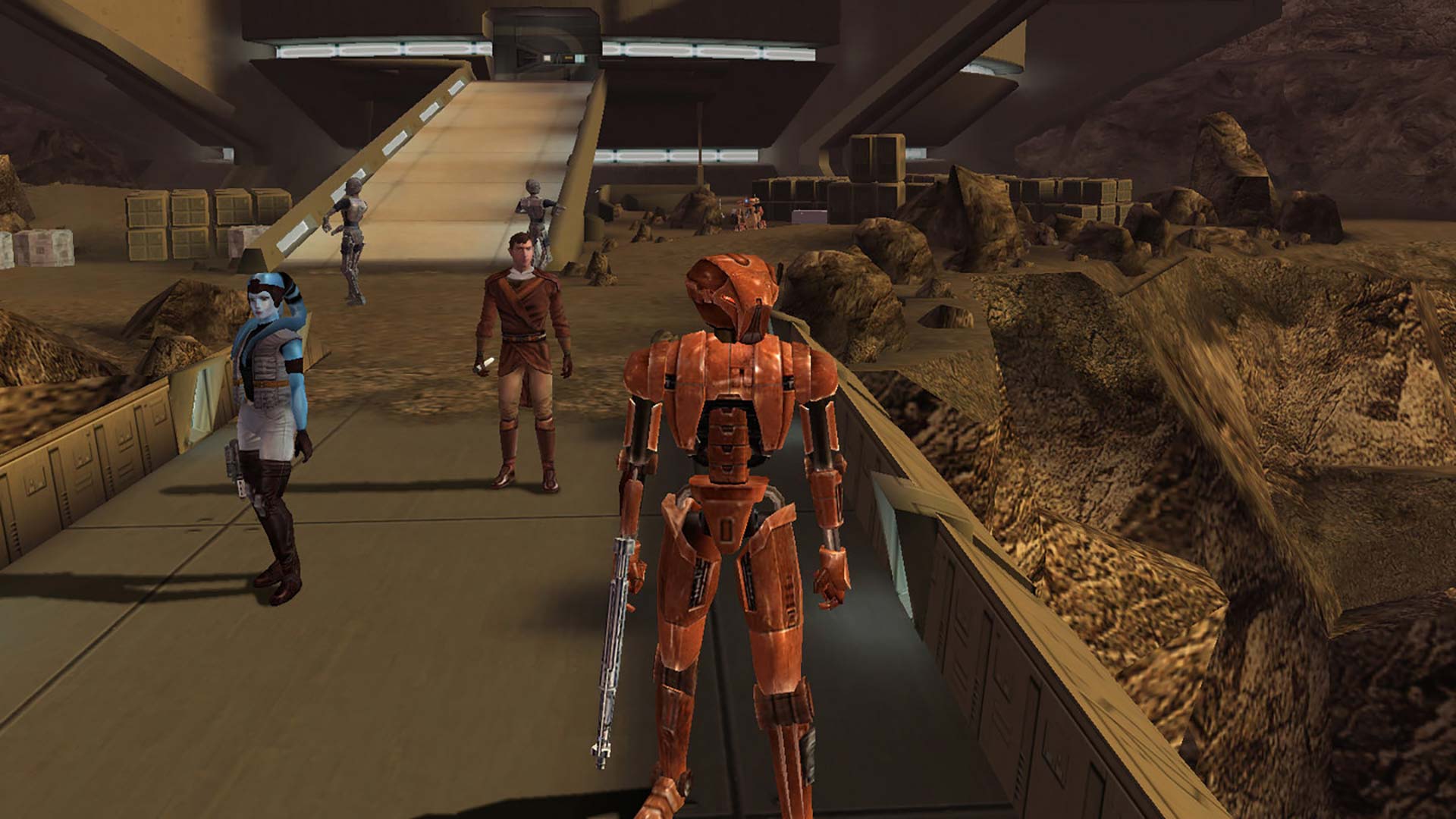
HK-47, KOTOR‘s bloodthirsty assassin droid, is a fan favourite. (Image credit: Disney)
HK-47 would be wonderful to see, I think there’s very much a spot for that. And I think even in Rogue One, we got a little bit of snark [with K-2SO]. And I’m not gonna say we were the first one to come up with snarky robots, because we weren’t, but it feels like [director] Gareth [Edwards] may have played KOTOR at some point. [laughs] I’m not suggesting that’s the case — I only talked to him when he was on Godzilla. But I know he is a big Star Wars fan, and seeing a snarky ass droid? If he had called anyone a meatbag, I would have been like, ‘alright, that’s a little on the nose!’ [laughs]
Fondest memories and proudest moments
It’s rare for something to remain so beloved 20 years later and, rarer still, be regarded as one of the best of its class. As such, everyone has their own favourite part of KOTOR, be it the masterful Revan twist, the riotously bloodthirsty assassin droid HK-47, the fascinating Sith world of Korriban, or that side quest in which you have to play both private detective and lawyer in the suspicious murder of a Sith apprentice. Here are some of the KOTOR creators’ most cherished moments from working on the game.

Carth Onasi. (Image credit: Disney)
James Ohlen: There are so many moments. Like when Brad Prince, who was the cinematic designer, snuck in at the end where you can get Darth Malak to do the dance-off. That was back when still when designers could put in hacks that would actually be a benefit. He did that all on his own and it was awesome. But that’s not one of my things. Then there’s obviously the twist.
[Note: since Ohlen came up with rough ideas for many of the characters, we also asked about his favourite, noting that he’d once mentioned Carth Onasi in a 10-year-old interview.]
I don’t know if [Carth] is my favourite character because I know he was polarizing. I was like, [writer] Dave Gaider, why did you do that to my [character]?” [laughs] The thing is, I always was the Dungeon Master, but there was one Star Wars campaign where I was a player and I named my character ‘Carth.’ For the rest of the characters, Bastila was from the campaign, Canderous was from the campaign… Zaalbaar… Mission… Darth Revan… In the early games, I drew a lot of stuff from my tabletop experiences — basically for Baldur’s Gate and KOTOR, and then after that, not so much. But yeah, I’d say my favourite character is probably what everyone else’s favourite character is: HK-47, because Dave Gaider did such an amazing job writing him.
Drew Karpyshyn: For me, the execution of the big twist was a watershed moment in video game narrative. We worked hard to make sure we laid the groundwork and left clues, then called back to them with carefully constructed flashbacks. The sequence feels a bit dated now because of how much narrative in games has evolved, but for the time it was truly revolutionary and I’m still proud of how we brought everything together in that pivotal scene.
[…] I think my favourite quest was one that didn’t actually end up in the game. The dueling ring on Taris actually had an easter egg that we wrote, but never got to implement. We had a planned encounter where you ran into Deadeye Duncan — the worst dueler on Taris — later in the game. You learn that through a series of comic mishaps, he survived the destruction of Taris and had been travelling the galaxy living off your reputation as the legendary duelist “The Mysterious Stranger.” You could then help him out if you were Light Side with tips and pointers or kill him for revenge if you were Dark Side.
Aaryn Flynn: There are a couple of things. I’m really proud of the combat system. I went on to then build the combat on Jade Empire and we grew and invested a lot more in it from that time, but I was really happy that KOTOR gives that lightsaber feeling. It’s all fake, of course, it doesn’t actually work. [laughs] But you got that impression, you got that feeling. But really, I think we were one of the first games, if not the first game, to really get the cinematic storytelling working. And I think it says a lot about where games are now and the desire to do that and we showed that we could do it — that a console, even as relatively un-powerful as the Xbox, could do this. When you see that on a larger screen that you get usually in your living room at this time, versus what you’re always on a PC at the time, a smaller monitor, it just began to open up this idea of, ‘It’s like I’m the star of my own movie.’ It was great, and I think that the success of KOTOR was really that it validated, for a lot of the industry, that kind of opportunity for storytelling.
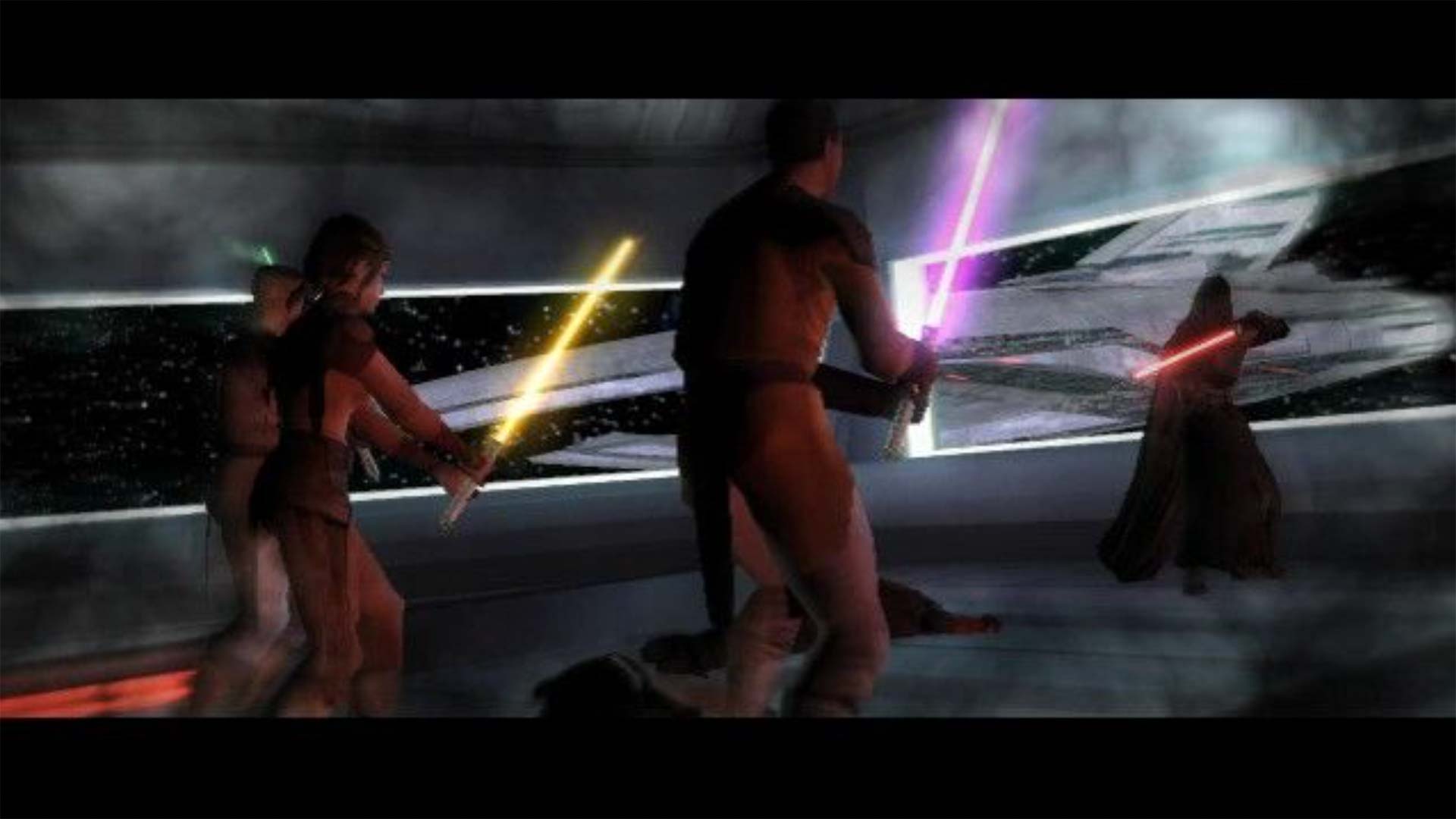
A mysterious flashback between Bastila and Revan is but one of KOTOR‘s many memorable cinematics. (Image credit: Disney)
[…] When we were shipping KOTOR, the way we shipped it back then — we don’t do it this way anymore, really — but because we were the developer and LucasArts was the publisher, we had to send the FTP of all things [file transfer protocol] build down to LucasArts, and then they would print the disk, and then they would test that disk, and then they would send us defects back that Microsoft would test, too. And so I finished my last bug on a Sunday — it would have been the third week of June. And my wife, who was seven-and-a-half months pregnant, was sitting on a couch all day in the studio while I was working and she was reading Harry Potter. She was there, and pregnant, and I was working, and I said ‘Six o’clock, I’ve finished my last bug, it’s good!’ I submitted it so the build could go off [to LucasArts].
And then, that night, my wife went into labour — our son was premature. And so she was in the hospital and the doctor said, ‘Everything’s fine, don’t worry about it, but we don’t want the young one to come out quite yet, so we’re just going to put you in a hospital bed. Lay down, relax, just hold back on the labour. And she did that for eight or nine days, until Kyle, our [first] son, was born. He’s 20 [now], it’s crazy. But what was [also] crazy was my life was, I’d get up in the morning at 5:30, 6am, I would go to the hospital, I would check on my wife, I would spend time with her, then I would go to the studio. And I would wait for bugs to come in from the playtesters at Microsoft and LucasArts, and if there was, we’d immediately try to rapidly fix it. And then, at the end of the day, I would go back to the hospital till about midnight and sit with my wife and I do that, and then I would go home and sleep for four or five hours and get up and do it again. And it was just one of the craziest times and then I can remember when Kyle was born and we got the certification, ‘It’s done. It’s going gold’ and this was all in the same 48 hours. […] Looking back on it, it was lunacy.
Steve Gilmour: I loved the experience. I loved working with Casey [Hudson], Derek Watts, Preston [Watamaniuk], James [Ohlen]… All those guys, we kind of grew up in the trenches. We’re all old BioWares, so we’ve all been around for a while. And by the time we got started, just the excitement of working on the IP, being chosen to play in this playground — that alone had me so jazzed. We went to the [Skywalker] Ranch, me and Greg Zeschuk, and Casey [Hudson] and Derek Watts and a few other people, like a pilgrimage down there. We got to see all the props. We met people high up in the game side in the LucasArts side of things, but not any of the film guys. We were too lowly game developers — ‘Who cares about those guys?’ [laughs] But it was cool to see the landscape.

Image credit: Disney
[…] For me, combat development has always been the thing I [love]. I was also the lead animator on Dragon Age Inquisition, which came out in 2014. And that’s a heavy melee combat game. I just love that stuff. I love the physicality, I love acting it out, picking up a toy lightsaber, and trying to act out that stuff. I enjoy that — to me, it’s really, really fun. Lightsaber combat, as much as we could get the flourishes, flinging that thing around… Using the staff, nobody had really done a staff up until that point, so animating and having fun with it. It was always about that Star Wars feel, and really looking at the first movie and dissecting what you see and thinking about it. And honestly, the lightsaber combat in the first three movies is so terrible. Those guys are just terrible, terrible, terrible, at physical acting as if they’re striking each other with who knows what. I would have a lot to say to Mark Hamill — he wouldn’t have liked me very much afterward. [laughs] I had a lot to say about that stuff. I like the sense of force; I want to see real contact. I grew up watching Douglas Fairbanks [Robin Hood, Zorro] duel with a sword. ‘You, Mark Hamill, need to practice and get a little fitter. Yes, you do.’ [laughs]
[…] I got to animate the Rancor, that was pretty fun. I got to animate a lot of little things, like the gizka. [laughs] Yeah, I animated the frogs! [laughs] HK-47, there was a bunch of us that touched him, but I definitely got to work on him a bit. He’s probably my favourite character. Him and Bastila, because she’s got a really mature, grown-up story arc. That’s the thing you don’t often see — this contrast from the gizka to Bastila. You have this goofy little, almost like [the] Star Trek [episode], “The Trouble with Tribbles” — that’s kind of what the gizka are, they keep appearing everywhere if you don’t deal with them, which is hilarious. But then there’s Bastila’s story where she’s clearly losing her soul, and that’s all in one game. That’s amazing! So I was lucky to be on that team because I had no idea how good the writers were, or how much stuff they were going to cram into that game. I’m still amazed, I still think about it. Man, those guys did a lot — all the crazy shit you can do. Talking [Zaalbaar] into murder[ing] Mission, like what the hell? [laughs] I couldn’t do it. I can’t play Dark Side, I just can’t do it. But we were trying to swing for the fences both ways. And honestly, it’s the good guy stuff that’s pretty boring. It’s the bad guy stuff that’s pretty hilarious, but you have to sit with yourself while you’re murdering Mission.
John Gallagher: I started doing Comic-Cons 10 years ago. I had done a Darth Revan illustration and people were like, ‘That’s Darth Revan — nobody ever draws Darth Revan!’ ‘What do you mean? He’s awesome!’ ‘Yeah, we agree, but nobody does illustrations of him.’ So I didn’t realize how beloved HK-47 was, a close second behind Revan. At the time, I didn’t have the attachment to the characters that I do now, because I’ve had the privilege of having people bear, many, many times, their love of those characters. So I think what happened is I kind of learned to really appreciate them after the fact.
[…] HK-47 was one drawing that took me 20 minutes. I basically pulled the body off a protocol droid, I made the shoulders wider, and I made his head look like a copperhead snake. And I just ‘droid-ed’ him. Obviously, it went through some modifications down that pipeline as it should, but hand to God, from my desk, it was 20 minutes. I walked down the hall, showed it to James [Ohlen] and he’s like, ‘Yeah, it’s perfect.’ There he is, done. And I didn’t have any significance attached to it. I just said, ‘Oh, that’s the assassin droid who’s a smart ass. Okay, moving on.’
[…] It was through direct conversation with fans — people have told me that the game took them through a really difficult time in their life, the death of a parent or the end of a marriage, like really tough times, and playing that game saved their life. They said it really is a thing that I owe a great deal of debt to and I’m like, ‘holy shit.’ So if you can be a part of something that has that kind of impact on people? What an enormous gift. And the only thing I could do in terms of paying back a gift like that is to honour it by always mentioning that I was part of a team. I’ve built an individual reputation after leaving BioWare, but while I was there, I was part of a team. And we were an incredibly talented team, collectively and individually, and we managed to do this incredible thing.”
Jennifer Hale: I think [the funny] moments are the best [referencing when the ‘stuck-up’ Bastila uses the Force to playfully knock over Mission]. They’re not all necessarily fresh in the front of my memory, but when you mention it, it absolutely comes back. And I love that stuff. I love that writing team. I love so many writing teams. I always say writers should be doing these interviews because they’re the ones who are the real stars — without them, we have nothing to do, and that means all of us in the industry. It was just so well-written and it was so fun and it was so vast. It was just an absolute blast […] I love those pieces of it. I really love the fandom. People are passionate about this game, and about Bastila, and it’s birthed some extraordinary art and creativity and amazing things, and it’s just so cool to see and be a part of it. I feel incredibly lucky.
The interview answers have been edited for style, clarity and length.
This is the first in a two-part series celebrating the 20th anniversary of KOTOR. The second part focuses on the 20 years since the game’s release, with the creators reflecting on the iconic RPG’s legacy within the Canadian gaming industry, the advancement of technology, their recent and current work and more.
James Ohlen, lead designer
 In many ways, the D&D-inspired KOTOR was the dream project for James Ohlen. “If I had two things that I was literally addicted to and spent all my waking hours with, it was Dungeons and Dragons and Star Wars,” the Grande Prairie native admits. He was able to marry his childhood passions thanks to Cameron Tofer, who helped him land an interview at BioWare. After serving as lead designer on the iconic first entry in the Baldur’s Gate series, a game based on the D&D licence, Ohlen was given the same role on Knights of the Old Republic, overseeing story, game systems and level design.
In many ways, the D&D-inspired KOTOR was the dream project for James Ohlen. “If I had two things that I was literally addicted to and spent all my waking hours with, it was Dungeons and Dragons and Star Wars,” the Grande Prairie native admits. He was able to marry his childhood passions thanks to Cameron Tofer, who helped him land an interview at BioWare. After serving as lead designer on the iconic first entry in the Baldur’s Gate series, a game based on the D&D licence, Ohlen was given the same role on Knights of the Old Republic, overseeing story, game systems and level design.
Drew Karpyshyn, lead writer
 After a car accident, Drew Karpyshyn left the financial industry to pursue creative writing and even ended up on Jeopardy! It’s a venture that paid off handsomely, as the Edmonton native would later join BioWare and get to contribute to the Dungeons & Dragons games Baldur’s Gate II and Neverwinter Nights. Somehow, he also found the time in between to dive into novel writing. All of this would tee him up to become the lead writer on KOTOR, getting his hands in all things narrative, although he says he most enjoyed contributing to Darth Malak, Mission and Zaalbaar.
After a car accident, Drew Karpyshyn left the financial industry to pursue creative writing and even ended up on Jeopardy! It’s a venture that paid off handsomely, as the Edmonton native would later join BioWare and get to contribute to the Dungeons & Dragons games Baldur’s Gate II and Neverwinter Nights. Somehow, he also found the time in between to dive into novel writing. All of this would tee him up to become the lead writer on KOTOR, getting his hands in all things narrative, although he says he most enjoyed contributing to Darth Malak, Mission and Zaalbaar.
Aaryn Flynn, programmer
 Since getting to try out the Intellivision in 1984, Aaryn Flynn has been an avid fan of games, but he never saw a career in that. “I think like a lot of folks, especially Canadians, I didn’t think about pursuing a career in game development until I was well into adulthood,” he admits. But at the encouragement of his girlfriend — and now wife — Flynn pursued a computer science degree and, eventually, ended up landing a job at BioWare right out of school. After cutting his teeth on developing tools for Baldur’s Gate II, Flynn got to work on KOTOR as a programmer.
Since getting to try out the Intellivision in 1984, Aaryn Flynn has been an avid fan of games, but he never saw a career in that. “I think like a lot of folks, especially Canadians, I didn’t think about pursuing a career in game development until I was well into adulthood,” he admits. But at the encouragement of his girlfriend — and now wife — Flynn pursued a computer science degree and, eventually, ended up landing a job at BioWare right out of school. After cutting his teeth on developing tools for Baldur’s Gate II, Flynn got to work on KOTOR as a programmer.
Steve Gilmour, lead animator
 Steve Gilmour has fond memories of growing up in Winnipeg and playing classics like Pong at the arcade. But he credits D&D and the 1992 DOS title Ultima Underworld for instilling in him a love for fantasy and interest in the then-burgeoning 3D games. After studying animation at the Vancouver Film School, he moved to Edmonton both to try his hand at BioWare and to be closer to his partner’s hometown and family. Fast forward a few years and he’d moved up the ranks through Baldur’s Gate animation work, paving the way for him to become lead animator on KOTOR, his “lucky number seven” project.
Steve Gilmour has fond memories of growing up in Winnipeg and playing classics like Pong at the arcade. But he credits D&D and the 1992 DOS title Ultima Underworld for instilling in him a love for fantasy and interest in the then-burgeoning 3D games. After studying animation at the Vancouver Film School, he moved to Edmonton both to try his hand at BioWare and to be closer to his partner’s hometown and family. Fast forward a few years and he’d moved up the ranks through Baldur’s Gate animation work, paving the way for him to become lead animator on KOTOR, his “lucky number seven” project.
John Gallagher, director of concept art
 John Gallagher’s journey into game dev is pretty unique. After spending his first 10 years in Sault Ste. Marie, Ontario, he moved to Edmonton and, eventually, got into broadcasting. But he always had a love for art and, as he puts it, “untethered geekery,” and the opportunity for both came knocking when he was doing a local interest story on BioWare creating medical software for the University of Alberta. This put him on the radar of BioWare co-founder Augustine Yip, and, through that, a future job opportunity to join the up-and-coming studio. After working on Baldur’s Gate, he was appointed director of concept art on KOTOR, helping to shape the look and feel of many of the game’s most iconic elements.
John Gallagher’s journey into game dev is pretty unique. After spending his first 10 years in Sault Ste. Marie, Ontario, he moved to Edmonton and, eventually, got into broadcasting. But he always had a love for art and, as he puts it, “untethered geekery,” and the opportunity for both came knocking when he was doing a local interest story on BioWare creating medical software for the University of Alberta. This put him on the radar of BioWare co-founder Augustine Yip, and, through that, a future job opportunity to join the up-and-coming studio. After working on Baldur’s Gate, he was appointed director of concept art on KOTOR, helping to shape the look and feel of many of the game’s most iconic elements.
Jennifer Hale, Bastila actress
 Jennifer Hale is practically gaming royalty, having been recognized by Guinness World Records as the most prolific video game actress. From Mass Effect and Metal Gear to Ratchet & Clank and Overwatch, the Happy Valley-Goose Bay, Labrador native can be heard in pretty much every corner of the gaming space, on top of countless shows and movies. It all started doing early voiceover and PA system work for commercials and the like. Eventually, she got larger roles in movies, TV and video games (chief among them: the 1998 classic Metal Gear Solid). Amid all of that, though, KOTOR remains a career highlight for Hale — so much so, in fact, that she’s set to reprise the role in the remake.
Jennifer Hale is practically gaming royalty, having been recognized by Guinness World Records as the most prolific video game actress. From Mass Effect and Metal Gear to Ratchet & Clank and Overwatch, the Happy Valley-Goose Bay, Labrador native can be heard in pretty much every corner of the gaming space, on top of countless shows and movies. It all started doing early voiceover and PA system work for commercials and the like. Eventually, she got larger roles in movies, TV and video games (chief among them: the 1998 classic Metal Gear Solid). Amid all of that, though, KOTOR remains a career highlight for Hale — so much so, in fact, that she’s set to reprise the role in the remake.
Star Wars: Knights of the Old Republic is available on Xbox One, Xbox Series X/S, Nintendo Switch, PC, Android and iOS.
Header image credit: Disney
MobileSyrup may earn a commission from purchases made via our links, which helps fund the journalism we provide free on our website. These links do not influence our editorial content. Support us here.


